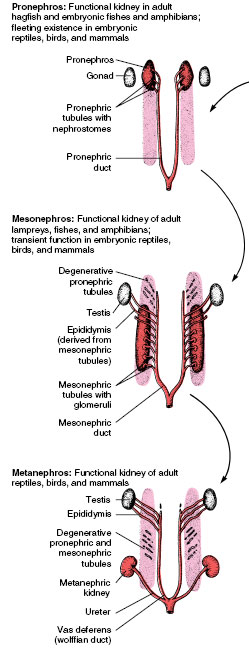Vertebrate Kidney
Vertebrate Kidney
Ancestry and Embryology
From comparative studies of development, biologists believe that the kidney of the earliest vertebrates extended the length of the coelomic cavity and was composed of segmentally arranged tubules, each resembling an invertebrate nephridium. Each tubule opened at one end into the coelom by a nephrostome and at the other end into a common archinephric duct. This ancestral kidney is called an archinephros (“ancient kidney”), and we find a segmented kidney very similar to an archinephros in embryos of hagfishes
and caecilians (Figure 32-9). Almost from the beginning, the reproductive system, which develops beside the excretory system from the same segmental blocks of trunk mesoderm, used the nephric ducts as a convenient conducting system for reproductive products. Thus even though the two systems have nothing functionally in common, they are closely associated in their use of common ducts.
Kidneys of living vertebrates developed from this primitive plan. During embryonic development of amniote vertebrates, there is a succession of three developmental stages of kidneys: pronephros, mesonephros, and metanephros (Figure 32-9). Some, but not all, of these stages are observed in other vertebrate groups. In all vertebrate embryos, the pronephros is the first kidney to appear. It is located anteriorly in the body and becomes part of the persistent kidney only in adult hagfishes. In all other vertebrates the pronephros degenerates during development and is replaced by a more centrally located mesonephros. The mesonephros is the functional kidney of embryonic amniotes (reptiles, birds, and mammals), and contributes to the adult kidney (called an opisthonephros) of fishes and amphibians.
The metanephros, characteristic of adult amniotes, is distinguished in several ways from the pronephros and mesonephros. It is more caudally located and it is a much larger, more compact structure containing a very large number of nephric tubules. It is drained by a new duct, the ureter, which developed when the old archinephric duct was relinquished to the reproductive system of the male for sperm transport. Thus three successive kidney types—pronephros, mesonephros, metanephros—succeed each other embryologically, and to some extent phylogenetically, in amniotes.
Ancestry and Embryology
From comparative studies of development, biologists believe that the kidney of the earliest vertebrates extended the length of the coelomic cavity and was composed of segmentally arranged tubules, each resembling an invertebrate nephridium. Each tubule opened at one end into the coelom by a nephrostome and at the other end into a common archinephric duct. This ancestral kidney is called an archinephros (“ancient kidney”), and we find a segmented kidney very similar to an archinephros in embryos of hagfishes
 |
| Figure 32-8 Malpighian tubules of insects. Malpighian tubules are located at the juncture of the midgut and hindgut (rectum). Solutes, especially potassium, are actively secreted into the tubules from the surrounding arthropod hemolymph. Water and wastes follow. This fluid drains into the rectum, where solutes and water are actively reabsorbed, leaving wastes to be excreted. |
and caecilians (Figure 32-9). Almost from the beginning, the reproductive system, which develops beside the excretory system from the same segmental blocks of trunk mesoderm, used the nephric ducts as a convenient conducting system for reproductive products. Thus even though the two systems have nothing functionally in common, they are closely associated in their use of common ducts.
Kidneys of living vertebrates developed from this primitive plan. During embryonic development of amniote vertebrates, there is a succession of three developmental stages of kidneys: pronephros, mesonephros, and metanephros (Figure 32-9). Some, but not all, of these stages are observed in other vertebrate groups. In all vertebrate embryos, the pronephros is the first kidney to appear. It is located anteriorly in the body and becomes part of the persistent kidney only in adult hagfishes. In all other vertebrates the pronephros degenerates during development and is replaced by a more centrally located mesonephros. The mesonephros is the functional kidney of embryonic amniotes (reptiles, birds, and mammals), and contributes to the adult kidney (called an opisthonephros) of fishes and amphibians.
The metanephros, characteristic of adult amniotes, is distinguished in several ways from the pronephros and mesonephros. It is more caudally located and it is a much larger, more compact structure containing a very large number of nephric tubules. It is drained by a new duct, the ureter, which developed when the old archinephric duct was relinquished to the reproductive system of the male for sperm transport. Thus three successive kidney types—pronephros, mesonephros, metanephros—succeed each other embryologically, and to some extent phylogenetically, in amniotes.
  |
| Figure 32-9 Comparative development of male vertebrate kidney. Red, functional structures. Light red, degenerative or undeveloped parts. |




